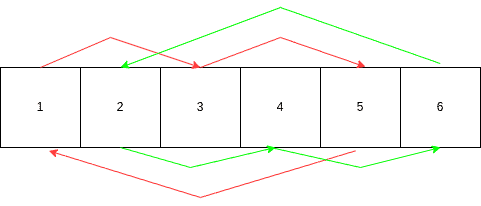1. 概述
本教程将介绍几种在Java中实现数组旋转的算法。我们将学习如何将数组元素向右旋转k次,并探讨如何在可能使用额外空间的情况下原地修改数组。
2. 数组旋转基础
在深入算法之前,我们先讨论如何构建旋转算法的思路。这里用字母k表示旋转次数。
2.1. 计算最小旋转次数
我们需要将k转换为k除以数组长度的余数,即k对数组长度取模(%)。这样可以将大旋转次数转换为等效的小旋转次数。
2.2. 单元测试要点
我们需要测试k小于、等于和大于数组长度的情况。例如,当旋转一个长度为6的数组8次时,实际只需要旋转2次。
同样,当k等于数组长度时,数组应保持不变。这是一个需要考虑的边界情况。
最后,我们还需要检查输入数组是否为null,以及k是否大于0。
2.3. 测试变量定义
我们定义以下测试变量:
-
arr:长度为6的测试数组 -
rotationLtArrayLength= 1:小于数组长度的旋转次数 -
rotationGtArrayLength= 8:大于数组长度的旋转次数 -
ltArrayLengthRotation:rotationLtArrayLength的预期结果 -
gtArrayLengthRotation:rotationGtArrayLength的预期结果
初始值如下:
int[] arr = { 1, 2, 3, 4, 5, 6 };
int rotationLtArrayLength = 1;
int rotationGtArrayLength = arr.length + 2;
int[] ltArrayLengthRotation = { 6, 1, 2, 3, 4, 5 };
int[] gtArrayLengthRotation = { 5, 6, 1, 2, 3, 4 };
2.4. 空间与时间复杂度
理解算法解决方案需要掌握时间复杂度和空间复杂度的基本概念。
3. 暴力解法
暴力解法是解决问题的常见思路。虽然效率不高,但有助于理解问题空间。
3.1. 算法实现
我们通过k步旋转,每步将所有元素移动一个单位:
void bruteForce(int[] arr, int k) {
// 检查无效输入
k %= arr.length;
int temp;
int previous;
for (int i = 0; i < k; i++) {
previous = arr[arr.length - 1];
for (int j = 0; j < arr.length; j++) {
temp = arr[j];
arr[j] = previous;
previous = temp;
}
}
}
3.2. 代码解析
我们使用嵌套循环遍历数组两次。外层循环获取要旋转的值:
for (int i = 0; i < k; i++) {
previous = arr[arr.length - 1];
// 嵌套循环
}
内层for循环通过临时变量将所有元素移动一位:
for (int j = 0; j < arr.length; j++) {
temp = arr[j];
arr[j] = previous;
previous = temp;
}
3.3. 复杂度分析
- **时间复杂度:O(n×k)*。所有元素在k*次循环中每次移动O(n)步。
- **空间复杂度:O(1)**。仅使用常数级别的额外空间。
3.4. 单元测试
测试k小于数组长度的情况:
@Test
void givenInputArray_whenUseBruteForceRotationLtArrayLength_thenRotateArrayOk() {
bruteForce(arr, rotationLtArrayLength);
assertArrayEquals(ltArrayLengthRotation, arr);
}
测试k大于数组长度的情况:
@Test
void givenInputArray_whenUseBruteForceRotationGtArrayLength_thenRotateArrayOk() {
bruteForce(arr, rotationGtArrayLength);
assertArrayEquals(gtArrayLengthRotation, arr);
}
测试k等于数组长度的情况:
@Test
void givenInputArray_whenUseBruteForceRotationEqArrayLength_thenDoNothing() {
int[] expected = arr.clone();
bruteForce(arr, arr.length);
assertArrayEquals(expected, arr);
}
4. 使用额外数组旋转
我们使用额外数组将每个元素放到正确位置,然后复制回原数组。
4.1. 算法实现
通过计算(i + k) % 数组长度确定旋转后的位置:
void withExtraArray(int[] arr, int k) {
// 检查无效输入
int[] extraArray = new int[arr.length];
for (int i = 0; i < arr.length; i++) {
extraArray[(i + k) % arr.length] = arr[i];
}
System.arraycopy(extraArray, 0, arr, 0, arr.length);
}
4.2. 代码解析
我们将每个元素从位置i移动到额外数组的(i + k) % arr.length位置。
最后使用*System.arraycopy()*将结果复制回原数组。
4.3. 复杂度分析
- **时间复杂度:O(n)**。一次遍历完成旋转,另一次复制回原数组。
- **空间复杂度:O(n)**。使用同等大小的额外数组存储旋转结果。
4.4. 单元测试
测试k小于数组长度的情况:
@Test
void givenInputArray_whenUseExtraArrayRotationLtArrayLength_thenRotateArrayOk() {
withExtraArray(arr, rotationLtArrayLength);
assertArrayEquals(ltArrayLengthRotation, arr);
}
测试k大于数组长度的情况:
@Test
void givenInputArray_whenUseExtraArrayRotationGtArrayLength_thenRotateArrayOk() {
withExtraArray(arr, rotationGtArrayLength);
assertArrayEquals(gtArrayLengthRotation, arr);
}
测试k等于数组长度的情况:
@Test
void givenInputArray_whenUseExtraArrayWithRotationEqArrayLength_thenDoNothing() {
int[] expected = arr.clone();
withExtraArray(arr, arr.length);
assertArrayEquals(expected, arr);
}
5. 循环替换
我们可以每次将元素替换到其目标位置,但会覆盖原值。因此使用临时变量保存被替换的值,重复此过程直到所有元素都被处理。
5.1. 算法实现
当k=2时,循环替换的逻辑如下图所示:
我们从索引0开始,进行2步循环。但这种方法有个问题:可能回到初始位置。此时需要重新开始常规循环。
我们使用count变量跟踪已替换的元素数量,当count等于数组长度时完成旋转:
void cyclicReplacement(int[] arr, int k) {
// 检查无效输入
k = k % arr.length;
int count = 0;
for (int start = 0; count < arr.length; start++) {
int current = start;
int prev = arr[start];
do {
int next = (current + k) % arr.length;
int temp = arr[next];
arr[next] = prev;
prev = temp;
current = next;
count++;
} while (start != current);
}
}
5.2. 代码解析
算法有两个关键部分:
外层循环处理每k步替换的元素组:
for (int start = 0; count < arr.length; start++) {
int current = start;
int prev = arr[start];
do {
// 循环体
} while (start != current);
}
内层do-while循环将值移动k步(保存被替换值),直到回到起始位置:
int next = (current + k) % arr.length;
int temp = arr[next];
arr[next] = prev;
prev = temp;
current = next;
count++;
5.3. 复杂度分析
- 时间复杂度:O(n)
- **空间复杂度:O(1)**。仅使用常数级别的额外空间。
5.4. 单元测试
测试k小于数组长度的情况:
@Test
void givenInputArray_whenUseCyclicReplacementRotationLtArrayLength_thenRotateArrayOk() {
cyclicReplacement(arr, rotationLtArrayLength);
assertArrayEquals(ltArrayLengthRotation, arr);
}
测试k大于数组长度的情况:
@Test
void givenInputArray_whenUseCyclicReplacementRotationGtArrayLength_thenRotateArrayOk() {
cyclicReplacement(arr, rotationGtArrayLength);
assertArrayEquals(gtArrayLengthRotation, arr);
}
测试k等于数组长度的情况:
@Test
void givenInputArray_whenUseCyclicReplacementRotationEqArrayLength_thenDoNothing() {
int[] expected = arr.clone();
cyclicReplacement(arr, arr.length);
assertArrayEquals(expected, arr);
}
6. 反转法
这是一个简单但巧妙的算法。旋转时,数组末尾的k个元素会移动到前面,其余元素向后移动。
6.1. 算法实现
通过三次反转完成旋转:
- 反转整个数组
- 反转前k个元素
- 反转剩余的(n-k)个元素
void reverse(int[] arr, int k) {
// 检查无效输入
k %= arr.length;
reverse(arr, 0, arr.length - 1);
reverse(arr, 0, k - 1);
reverse(arr, k, arr.length - 1);
}
void reverse(int[] nums, int start, int end) {
while (start < end) {
int temp = nums[start];
nums[start] = nums[end];
nums[end] = temp;
start++;
end--;
}
}
6.2. 代码解析
我们使用类似暴力解法的辅助方法,但分三步执行:
首先反转整个数组:
reverse(arr, 0, arr.length - 1);
然后反转前k个元素:
reverse(arr, 0, k - 1);
最后反转剩余元素:
reverse(arr, k, arr.length - 1);
虽然看起来多余,但这能让我们在线性时间内完成任务。
6.3. 复杂度分析
- **时间复杂度:O(n)**。所有元素总共被反转三次。
- **空间复杂度:O(1)**。仅使用常数级别的额外空间。
6.4. 单元测试
测试k小于数组长度的情况:
@Test
void givenInputArray_whenUseReverseRotationLtArrayLength_thenRotateArrayOk() {
reverse(arr, rotationLtArrayLength);
assertArrayEquals(ltArrayLengthRotation, arr);
}
测试k大于数组长度的情况:
@Test
void givenInputArray_whenUseReverseRotationGtArrayLength_thenRotateArrayOk() {
reverse(arr, rotationGtArrayLength);
assertArrayEquals(gtArrayLengthRotation, arr);
}
测试k等于数组长度的情况:
@Test
void givenInputArray_whenUseReverseRotationEqArrayLength_thenDoNothing() {
int[] expected = arr.clone();
reverse(arr, arr.length);
assertArrayEquals(expected, arr);
}
7. 总结
本文介绍了多种将数组旋转k次的算法。我们从暴力解法开始,逐步深入到更高效的反转法和循环替换法(无需额外空间)。我们讨论了时间复杂度和空间复杂度,并介绍了单元测试和边界情况的处理。
本文所有代码可在GitHub上获取。
